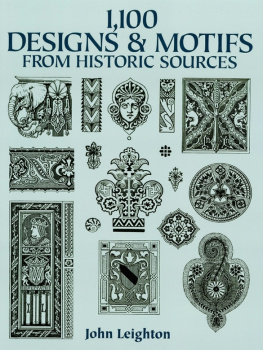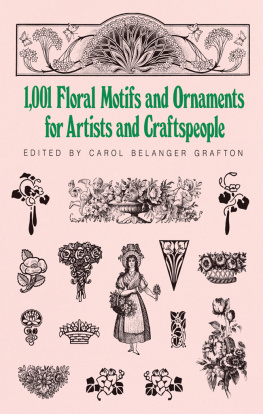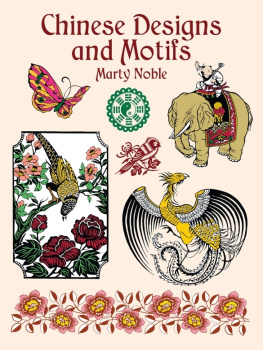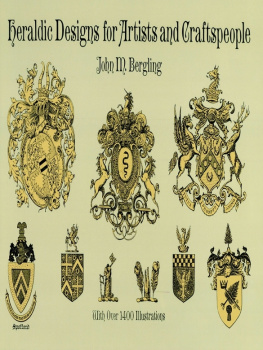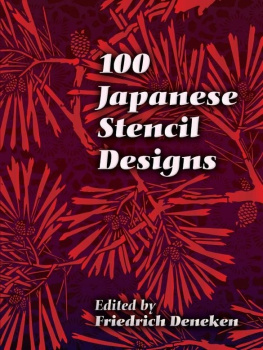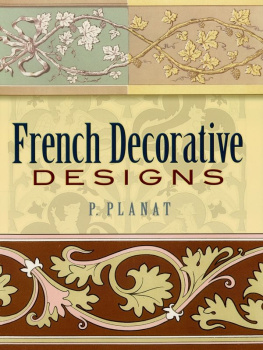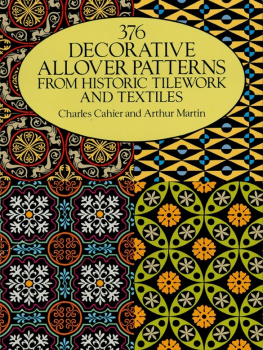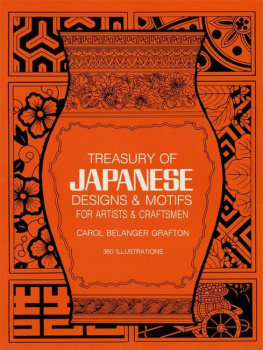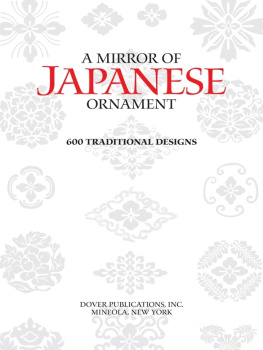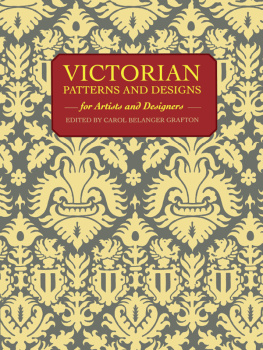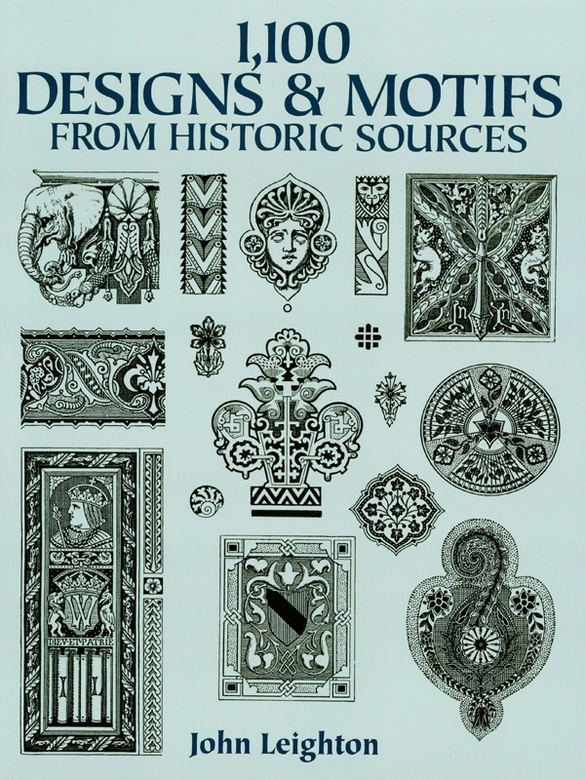SAVAGE AND EARLY TRIBES (PLATE 1)
PLATE 1 . Nos. 1 and 2. What are called frets or meanders are common in all early work; of such are these rude frets, which are ancient Mexican.
No. 3 is an ornament of somewhat similar character. Strange, uncouth variations of such forms, which possibly had a meaning of which we have no solution, are found in the ancient cities of Mexico and Central America. These ornaments are applicable to the enrichment of narrow bands of stonework or other material.
No. 4 may have been suggested by feathers, and consists of gracefully flowing lines, fitting one into the other. They represent incised lines engraved on a plain surface.
Nos. 5, 7, and 8 are enrichments for upright surfaces. The first appears like an impress in clay of a hieroglyphical character. No. 7 looks to be a series of birds heads piled one upon another, as on a door post, and reminds one of the rude cats heads of our own Norman work. No. 8 is evidently from matting. Similar zigzag lines are to be found worked out in many ways. The zigzag has been noticed by various archaeologists as being one of the earliest and most widely spread of all ornaments which are to be found among the most primitive works of mankind. We may easily imagine it commencing with the scratched lines on wet clay, or the alternate notching of a stick, as in , all of which are common on the clubs of the South Sea Islanders. These ornaments are all monotonous, and simple repetitions of the same form. Repetition, however, is one of the means of giving pleasure to the eye, so common, that it is of constant occurrence in every known style or mode of ornamentation. It is equally frequent in nature.




No. 6 is a peculiar example of a crowned figure, and may possibly represent a prisoner taken in battle, and condemned to occupy a confined and cramped position. The head has a beard, the biceps of the arm is indicated by a scroll, and although nearly bodiless, the knee, calf, and ankle-bone are clearly expressed, but in an odd conventional manner.
No. 9 consists of flowing and interlacing lines, combined with faces, and running into a beak or species of birds head at the top.
No. 10 may represent a mask with large goggle eyes, mouth and tongue. It is after the manner of a tattoed face, as seen among the New Zealanders.
No. 11 exhibits the use of colours, consisting of red, black, and white, and is apparently taken from leaning blocks, such as bricks, each being impressed with a stamp. If made continuous, it will be observed that the red and black alternate at regular intervals.
No. 12 is a carved idol, which besides the rudely formed side figures of grotesque shapes, contains in the centre the suggestion of a face with two eyes, appearing as if rising above the triangle.
No. 13 is ancient Mexican. It is strange and uncouth, without much beauty of form, and probably contains the name of some great personage or king, as the centre is formed of what appear to be arbitrary characters.
No. 14 is a diaper with animal or cats head, triangles and stripes. It also serves to show how prevalent geometrical figures were, even in the rudest ages. The angle squares contain a diagonal cross or saltire with square centre containing a diagonal square of the same breadth as the saltire. These angle squares might easily pass for medival tiles.
Nos. 15, 16, and 17 are applicable for bands of stonework executed in relief or incised. No. 15 may have been suggested by steps added to an imperfect fret. No. 16 by the surf of the sea. A somewhat similar form is found in the Greek. No. 17 is an incised line consisting of two alternating semicircles dove-tailing into one another, looking like a folded ribbon or plaited cloth.
Many more rude yet highly suggestive forms might have been given, but these are considered sufficient, to give a tolerable idea of the primitive efforts of mankind in the ornamentation of surface.
EGYPTIAN (PLATES 24)
PLATE 2 . No. 1. Head crowned with leaves and buds. The beard and hair crimped horizontally as represented in Egyptian sculpture.
No. 2. Frieze with flowers and buds in low relief growing from water.
No. 3. Geometrical arrangement of leafage or palm grove, with crowned serpents below. The haje, or African cobra, when excited stands erect and swells out its body as here represented. The serpent was considered sacred in Egypt. It is not uncommon to find entire sculptured friezes and borders composed of a succession of these cobras, each surmounted by a disk to indicate their sacred character.
No. 4. The papyrus in flower, bud, and seed. It is thus represented in low relief on the pedestal or altar in front of Hapimoon, the god of the Nile, with other aquatic offerings. The statue is in black granite, and is now in the British Museum. It was brought from Karnac.
No. 5. Frieze or cavetto containing heads of the goddess Isis, which are thus found crowned with small temples. The heads are alternated with serpents and palm-trees.
No. 6. Leaf cornice. The only kind of cornice found (if it can be called a cornice) is formed by a large hollow springing from a torus or bold bead.
No. 7. Frieze of lotus and cartouche alternating. Hieroglyphics surrounded by an oval line either upright or horizontal, called a cartouche, are of frequent occurrence and indicate a proper name, as that of a monarch, the one in the centre of this example reading KLEOPATRA. The two signs on either side of the lower bird indicate the feminine.
No. 8. One-half of a bell-shaped capital, developed or laid out flat. Many of the capitals have the upper portion or lip of the bell formed of four arcs of a circle surrounding a square, after the manner of a quatrefoil.
No. 9. Lotus growing in water, with band of eyes and stars above. Water was usually represented by zigzag lines. The band containing the star indicated the heavens, and, probably, the eyes represented those of the deities, looking down upon the acts of men.
No. 10. Symmetrical arrangement of elongated incised lines with lotus and buds.
No. 11. Ornament formed of the lotus. Band of reeds and vulture. The universal application of the lotus, or water-lily of the Nile, which was a sacred plant among the Egyptians, is very remarkable, and is found in every variety among the paintings and sculpture.
PLATE 3 . No. 1. Baboons and fig-tree. The power of the Egyptian artists in expressing the character of animals by little more than simple outline was very remarkable.
No. 2. Bundles of lotus with the haje or cobra surmounted by a globe or sun.
No. 3. Spoon or ladle formed of a slave bearing on his head a bundle of reeds and lotus. In the Louvre and British Museum are many utensils ornamented by the lotus, but the use of the figure in this instance is somewhat questionable. There are examples also of a fish being converted into a dish, a hand into a scoop, &c., but such instances are rare. These conceits, however, are not confined to the Egyptians, for we find Etruscan and early Greek vases composed of figures and heads, with cavities in the cranium (

